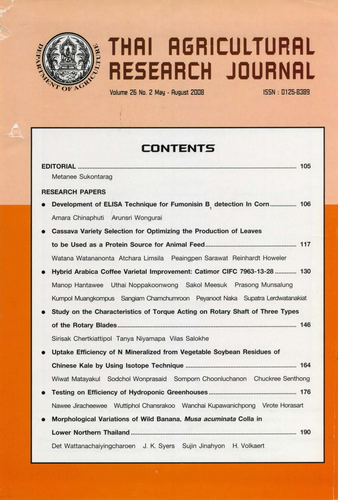Study on the Characteristics of torque Acting on Rotary Sharft of Three Types of the Rotary Blades
DOI:
https://doi.org/10.14456/thaidoa-agres.2008.13Keywords:
torque, Japanese C-shaped blade, European L-shaped blade, European C-shaped blade, sandy loam soil, clay soilAbstract
The characteristics of torque acting on the rotary shaft of the Japanese C-shaped blade, the European L-shaped blade and the European c-shaped blade, which were related to the positions of the tip blades in the tilling process, were studied in order to understand the tilling processes of all tested rotary blades. These experiments were carried out in the laboratory using soil bin at forward speed of 0.034 and 0.069 m/s and at rotational speeds of 150, 218, 278 and 348 rpm under down-cut process in sandy loam and clay soils. The results showed that the shape of teh test rotary blade was an influential and important parameter that afferct to the torque characteristic. In the case of the Japanese C-shaped blade, there was raising torque concurrent with the approach of its tip blade in range of 75 to 87. The torque increased continuously until it achieved to maximum value in range of 108 to 125 and then it decreased. In cases of the European L-shaped blade and the European C-shaped blade, the tilling torque immediately increased while their curvatures between lengthwise blade and tip blade portions were directly cutting into soil mass. These maximum torque values appeared in ranges of 111 to 120 and 102 to 120, respectively. After the maximum torques was obtained, they also immediately decreased. And then the torque curves characterized in the form of the sinusoidal curves. Moreover, the soil throwing patterns of the Japanese C-shaped blade, the European L-shaped blade and the European C-shared blade were also presented.
Downloads
Published
How to Cite
Issue
Section
License
Copyright (c) 2017 วารสารวิชาการเกษตร (Thai Agricultural Research Journal)

This work is licensed under a Creative Commons Attribution-NonCommercial-NoDerivatives 4.0 International License.
Thai Agricultural Research Journal



